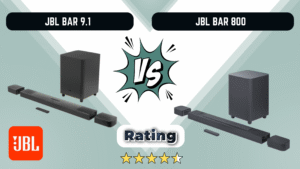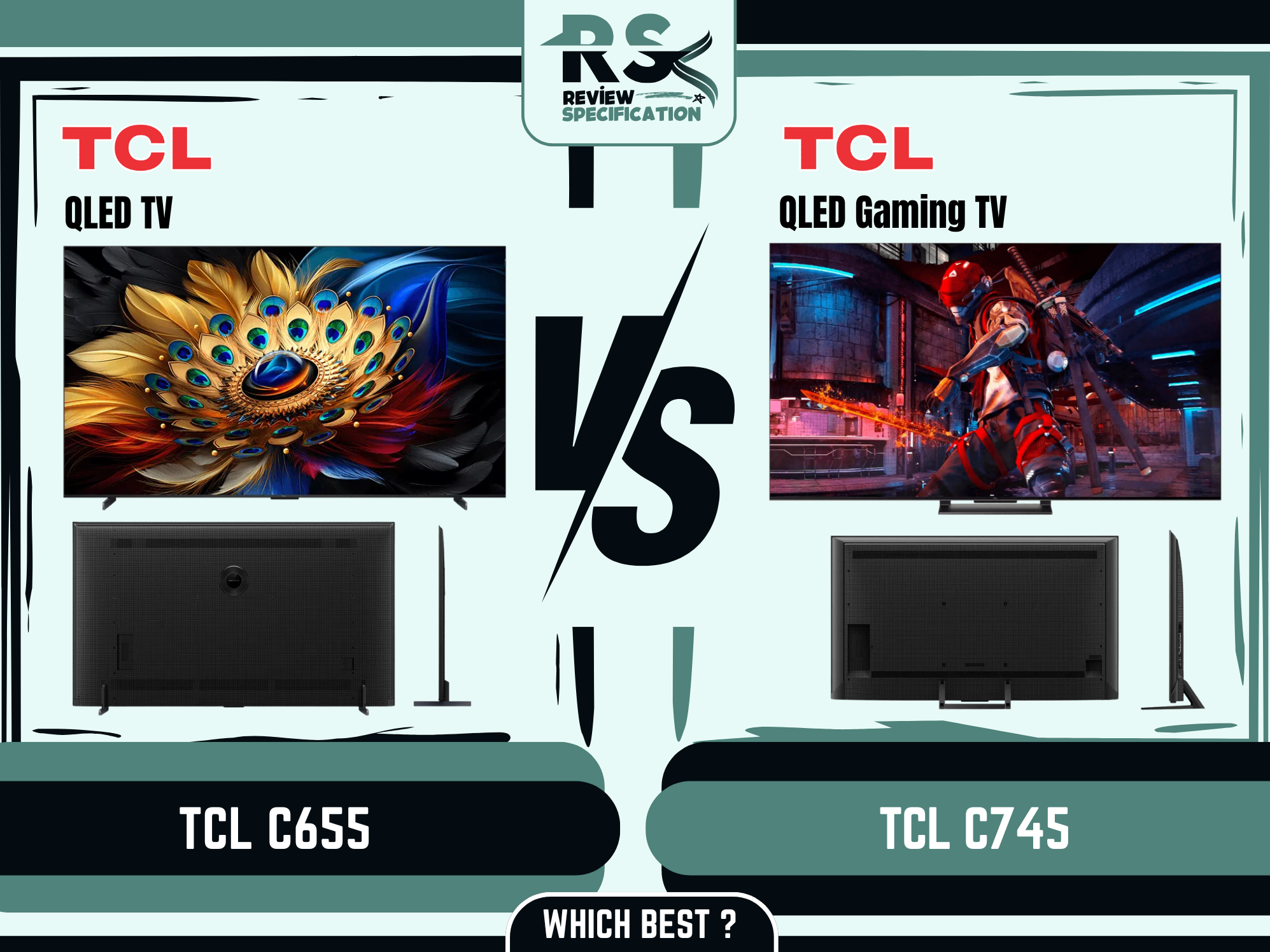
JBL Bar 9.1 vs JBL Bar 800 Which Best – Ultimate Soundbar Comparison
Seeking an elite soundbar system to take your home theater to the next level? JBL Bar series boasts some of the most immersive soundbars available, and the JBL Bar 9.1 and JBL Bar 800 are two of the best models out there, providing mind-blowing Dolby Atmos sound. In this in-depth comparison, we’re going to see how these two top-of-the-line soundbar systems compare to one another so that you can make the right choice for your entertainment system.
Company Details & Release Date
| JBL Bar 9.1 | JBL Bar 800 |
| Brand: JBL Series: Bar Series Year: 2020 Model: JBLBAR913DBLKAM |
Brand: JBL Series: Bar Series Year: 2022 Model: JBLBAR800PROBLKAM |
Full Specifications Comparison
| Specifications | JBL Bar 9.1 | JBL Bar 800 |
|---|---|---|
| Build & Design | ||
| Main Soundbar Dimensions (W×H×D) | 884 × 62 × 120 mm (34.8″ × 2.4″ × 4.7″) | 884 × 56 × 120 mm (34.8″ × 2.2″ × 4.7″) |
| Detachable Speaker Dimensions (each) | 173 × 60 × 120 mm (6.8″ × 2.4″ × 4.7″) | 145 × 56 × 120 mm (5.7″ × 2.2″ × 4.7″) |
| Subwoofer Dimensions (W×H×D) | 305 × 440 × 305 mm (12.0″ × 17.3″ × 12.0″) | 305 × 440.4 × 305 mm (12″ × 17.3″ × 12″) |
| Soundbar Weight | 3.64 kg (8.0 lb) | 3.4 kg (7.4 lbs) |
| Detachable Speaker Weight (each) | 0.72 kg (1.6 lb) | 1.3 kg (2.8 lbs) |
| Subwoofer Weight | 11.10 kg (24.5 lb) | 10 kg (22 lbs) |
| Total System Weight | 16.18 kg (35.7 lb) | 16 kg (35 lbs) |
| Performance & Speed | ||
| Total System Power Output | 820W (Max @THD 1%) | 720W (Max @THD 1%) |
| Soundbar Output Power | 400W | 340W |
| Surround Speaker Output Power (each) | 60W × 2 | 40W × 2 |
| Subwoofer Output Power | 300W | 300W |
| Frequency Response | Not specified | 35Hz – 20kHz (-6dB) |
| Sound & Audio | ||
| Audio Technology | Dolby Atmos, DTS:X | Dolby Atmos |
| Soundbar Transducers | 4 racetrack drivers + 2 up-firing full-range drivers + 3 × 0.75″ (20mm) tweeters | 3 × (46×90)mm racetrack drivers, 3 × 0.75″ (20mm) tweeters, 2 × 2.75″ (70mm) up-firing full-range drivers |
| Surround Speaker Transducers (each) | 1 up-firing full-range driver + 0.75″ (20mm) tweeter | 1 × (46×90)mm racetrack driver |
| Subwoofer Transducer | 10″ (254mm) | 10″ (260mm) |
| Audio Configuration | 5.1.4 channel configuration | 5.1.2 channel configuration |
| Battery & Power | ||
| Detachable Speaker Battery | Up to 10 hours playback | Not specified (Uses 3.635V, 3283mAh Lithium battery) |
| Battery Charging Time | 3 hours | Not specified |
| Power Supply | 100 – 240V AC, ~ 50/60Hz | 100 – 240V AC, ~ 50/60Hz |
| Standby Power | < 0.5W (Soundbar), < 2.0W (Subwoofer) | < 2.0W (Networked standby) |
| Software & Smart Features | ||
| Streaming Services | Chromecast, AirPlay 2 | Chromecast Built-in, AirPlay, Alexa Multi-Room Music (MRM) |
| Voice Assistant Compatibility | None built-in | Works with Alexa |
| Wi-Fi Connectivity | IEEE 802.11 a/b/g/n/ac (2.4GHz/5GHz) | IEEE 802.11 a/b/g/n/ac/ax (2.4GHz/5GHz) |
| Software Updates | Not specified | Automatic software updates via Wi-Fi |
| Connectivity & Ports | ||
| HDMI Inputs | 1 | 1 |
| HDMI Output | 1 (eARC) | 1 (eARC) |
| HDMI HDCP Version | 2.3 | 2.3 |
| Optical Input | 1 | 1 |
| USB Port | Yes (Type A) | Yes (Type A) |
| Bluetooth Version | 4.2 | 5.0 |
| HDR Support | Not specified | HDR10, Dolby Vision |
| Price & Availability | ||
| MSRP | $999.95 | $899.95 |
| Current Market Price | $799.95 – $899.95 (varies by retailer) | $699.95 – $799.95 (varies by retailer) |
| Availability | In stock at most major retailers | In stock at most major retailers |
Note: Prices may change over time and can vary by country. Please check the official website or authorized retailer for the most accurate and up-to-date pricing.

Overall Rating
JBL Bar 9.1: ⭐⭐⭐⭐⭐ (4.7/5)
JBL Bar 800: ⭐⭐⭐⭐½ (4.5/5)
Customer Feedback Reviews
| JBL Bar 9.1 | JBL Bar 800 |
|---|---|
| Average Rating: 4.5/5 Positive Comments:
Negative Comments:
|
Average Rating: 4.3/5 Positive Comments:
Negative Comments:
|
Pros & Cons
JBL Bar 9.1
Pros
- True 5.1.4 channel configuration for immersive 3D sound
- Higher total power output (820W vs 720W)
- Detachable speakers with up-firing drivers
- Supports both Dolby Atmos and DTS:X
- Up to 10 hours of battery life on detachable speakers
- Lighter detachable speakers make placement easier
Cons
- More expensive than the Bar 800
- Older Bluetooth version (4.2 vs 5.0)
- No Alexa Multi-Room Music support
- No HDR10/Dolby Vision pass-through specification
- Slightly older Wi-Fi technology
JBL Bar 800
Pros
- More affordable than the Bar 9.1
- Newer Bluetooth 5.0 technology
- Enhanced WiFi with 802.11ax support
- Alexa Multi-Room Music integration
- Automatic software updates via Wi-Fi
- Confirmed HDR10 and Dolby Vision pass-through
Cons
- 5.1.2 channel configuration (vs 5.1.4 on Bar 9.1)
- Lower total power output (720W vs 820W)
- Heavier detachable speakers
- No DTS:X support
- Surround speakers lack up-firing drivers
Comparison Description
When comparing the JBL Bar 9.1 vs JBL Bar 800 Which Best for your home theater setup, a number of differences are evident that may affect your choice.
Sound Quality & Configuration
The JBL Bar 9.1 features a genuine 5.1.4 channel configuration with four up-firing speakers (two inside the soundbar, one in each of the removable speakers), whereas the JBL Bar 800 boasts a 5.1.2 channel setup with two up-firing drivers situated within the main soundbar. This provides the Bar 9.1 with a benefit in terms of having a more enveloping overhead Dolby Atmos experience, particularly when the removable speakers are positioned behind the listener.
Raw power-wise, the Bar 9.1 delivers more at 820W total output than the Bar 800’s 720W. The central soundbar on the 9.1 drives 400W (compared to 340W on the 800), and the surround speakers each produce 60W (compared to 40W on the 800). Both systems have the same 300W subwoofers with 10-inch drivers for room-shaking bass performance.
A further important benefit of the Bar 9.1 is that it supports both Dolby Atmos and DTS:X formats, but the Bar 800 does not have DTS:X support. This makes the 9.1 more versatile with source material, especially for Blu-ray collections that tend to use DTS:X.
Design & Portability
Both soundbars have removable wireless surround speakers that can be positioned anywhere in the room without the use of power cables, providing a real surround sound experience. The Bar 9.1’s removable speakers are much lighter (0.72kg each) than the Bar 800’s heavier speakers (1.3kg each), making them easier to position.
The Bar 9.1 also indicates a maximum battery life of up to 10 hours for its removable speakers, while the Bar 800 doesn’t specify its battery life, although it employs a 3.635V, 3283mAh lithium battery in both its speakers.
Connectivity & Smart Features
The JBL Bar 800 excels in connectivity and modern features. It offers Bluetooth 5.0 (vs 4.2 on the 9.1) and newer Wi-Fi standards (802.11ax). The Bar 800 also features Alexa Multi-Room Music, Chromecast, and AirPlay support, making it a leader in the smart home ecosystem.
Another advantage of the Bar 800 is its support for HDR10 and Dolby Vision pass-through, which isn’t clearly indicated for the Bar 9.1. The Bar 800 also supports automatic software updates over Wi-Fi, keeping it current with new features and enhancements.
Value Proposition
The price gap favors the JBL Bar 800, which usually sells for around $100-200 less than the Bar 9.1. This makes the Bar 800 a more affordable choice without sacrificing great Dolby Atmos performance, though it has a slightly less immersive 5.1.2 channel setup compared to the Bar 9.1’s 5.1.4.
Considering JBL Bar 9.1 vs JBL Bar 800 Which Best for various user needs, the Bar 9.1 is best suited for audiophiles and home theater enthusiasts who desire maximum Dolby Atmos immersion with four overhead channels and compatibility with both leading 3D audio codecs. The Bar 800 offers excellent value with newer connectivity technologies and smart home integration at a lower price.
Final Verdict
Having carefully pitted the JBL Bar 9.1 vs JBL Bar 800 Which Best for all scenarios, our final verdict is that both deliver outstanding quality for their respective prices but with different strengths:
Go for the JBL Bar 9.1 if:
- You desire the ultimate Dolby Atmos experience with four up-firing speakers
- You require support for both Dolby Atmos and DTS:X
- You want the most powerful output for larger spaces
- You like having up-firing drivers on both the soundbar and surround speakers
- You desire lighter removable speakers with tested 10-hour battery life
Select the JBL Bar 800 if:
- You desire better value for money without sacrificing Dolby Atmos
- You prefer newer connectivity options such as Bluetooth 5.0 and Wi-Fi 6
- You want Alexa Multi-Room Music support
- You require HDR10 and Dolby Vision pass-through
- You appreciate automatic software updates over Wi-Fi
In our evaluation, the JBL Bar 9.1 remains the go-to for uncompromising audio performance and immersion, making it the better choice for serious home theater enthusiasts. But the JBL Bar 800 offers about 90% of the experience at a reduced cost with updated smart features, making it the more pragmatic choice for the average consumer.
Ultimately, the decision between JBL Bar 9.1 vs JBL Bar 800 Which Best depends on whether the extra immersion from the additional up-firing speakers and slightly greater power output justifies the higher cost for your specific requirements.
Both soundbars exemplify JBL’s efforts to bring cinema-quality Dolby Atmos sound into the home, and either would be a great addition to elevate your home entertainment experience.
Customer Comparison FAQs
What is better for films: JBL Bar 9.1 or JBL Bar 800?
For films, the JBL Bar 9.1 is a shade superior thanks to its 5.1.4 channel setup (compared to 5.1.2 on the Bar 800) and support for both Dolby Atmos and DTS:X formats. The extra up-firing drivers in the detachable surround speakers provide a more realistic overhead sound experience, which is especially apparent during action sequences with a lot of vertical sound action. Nevertheless, the Bar 800 still provides great movie performance with genuine Dolby Atmos and verified HDR10/Dolby Vision pass-through.
Do I need to charge the detachable speakers on both models?
Yes, both JBL Bar 9.1 and JBL Bar 800 have battery-powered removable surround speakers that must be charged. The JBL Bar 9.1 quantifies up to 10 hours of playtime with a 3-hour charge, whereas the JBL Bar 800 doesn’t specify a battery life but uses a 3.635V, 3283mAh lithium battery. Both sets allow you to place the removable speakers back on the main soundbar for recharging.
Can I connect my TV to either soundbar using Bluetooth?
Although both soundbars have Bluetooth connectivity (version 4.2 for the Bar 9.1 and 5.0 for the Bar 800), it is highly recommended to connect your TV using HDMI eARC or optical for the best audio quality and to support Dolby Atmos. Bluetooth connections generally do not support the bandwidth necessary for high-quality surround sound formats and can introduce audio delay during video playback.
Will these soundbars work with any TV brand?
Yes, both the JBL Bar 9.1 and JBL Bar 800 can be used with any TV that has HDMI ARC/eARC or optical audio output connections, regardless of brand. To enjoy Dolby Atmos content optimally, your TV must support HDMI eARC and Dolby Atmos pass-through. They also connect directly to streaming devices, Blu-ray players, or game consoles through their HDMI inputs.
Do I have to subscribe to use Dolby Atmos with these soundbars?
No subscription is needed for the soundbars to decode Dolby Atmos signals. However, to play Dolby Atmos content, you may need subscriptions to streaming services that offer Atmos (such as Netflix Premium, Disney+, or Amazon Prime Video), or you can play Atmos content from Blu-ray discs. Both soundbars will automatically play Dolby Atmos when available.
Which model is best for listening to music?
Both sound excellent for music, but each has different strengths. The JBL Bar 9.1 produces more power (820W vs 720W) and can deliver improved dynamic range suitable for genres like classical and orchestral. The JBL Bar 800, with Bluetooth 5.0 and more streaming capabilities including Alexa Multi-Room Music, is more versatile for everyday music streaming. For audiophiles, the extra power of the Bar 9.1 may be preferable, while the Bar 800 offers superior connectivity features.
Can I wall mount both soundbar models?
Yes, both models include wall-mounting brackets in the packaging. There are 2 L-shaped brackets for the soundbar and 2 U-shaped brackets for the surround speakers, along with screws and a wall mount template. The installation process is the same for each.
Is the JBL Bar 800 newer than the JBL Bar 9.1?
Yes, the JBL Bar 800 was released in 2022, while the JBL Bar 9.1 came out in 2020. This means the Bar 800 features newer Bluetooth 5.0, advanced Wi-Fi standards, and additional smart features like Alexa Multi-Room Music support and automatic software updates.
Can I add more speakers to either system?
No, neither the JBL Bar 9.1 nor the JBL Bar 800 supports adding more speakers beyond what comes in the box. They are complete systems with wireless surround speakers and a wireless subwoofer, but they are not expandable with additional satellite speakers or subwoofers.
Which one is better for gaming?
For gaming, both provide immersive sound experiences, but the JBL Bar 9.1 has an edge due to its extra up-firing drivers in the surround speakers and DTS:X support (used by some games). The JBL Bar 800 offers better connectivity with Bluetooth 5.0 and Wi-Fi. If you primarily connect your console via HDMI, the Bar 9.1‘s superior surround capabilities make it the best choice for immersive gaming.














Leave feedback about this